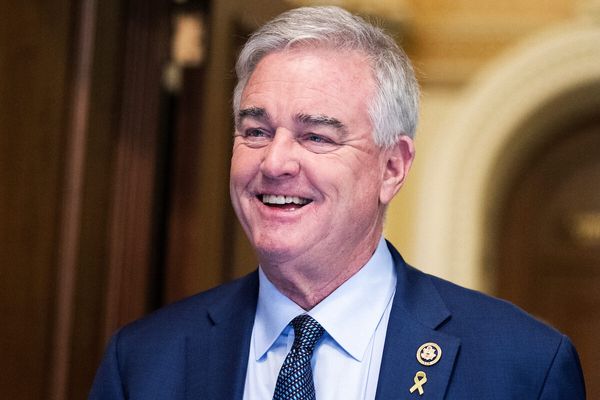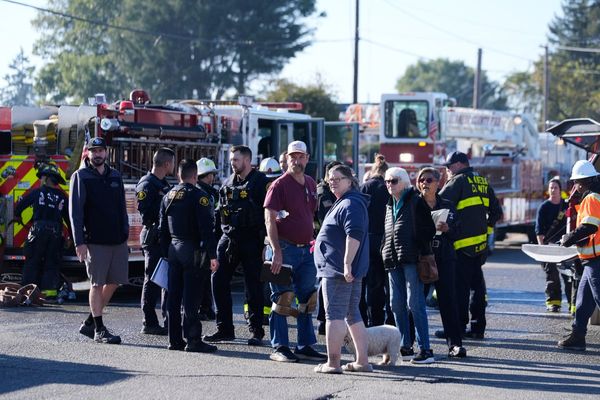
About two dozen movies have topped the box office in 2025, and it’s safe to say that Paul Thomas Anderson’s One Battle After Another is the only one that depicts its protagonists freeing arrested immigrants from detention centers. The movie doesn’t face much competition for the title of most political weekend-topper of the year; superhero pictures such as Captain America: Brave New World perpetually tell the most anodyne stories possible, even when they’re supposedly about Washington-based conspiracies; Sinners conceals some of its bigger ideas within a crime-and-horror vampire story; even Mickey 17, another riskily expensive Warner Bros movie from a beloved auteur with political overtones, has genre-movie trappings. On the other hand, some rightwing pundits suggested in all seriousness that Warner should have delayed the release of Anderson’s movie in the wake of the Charlie Kirk shooting, wondering if the movie was an incitement to political violence.
Some fans of the movie have described it in similar terms, too; not as an incitement to violence, but as the rare major-studio project bold enough to endorse a more pointed political position than “we can all agree that extremist-fostered racism can, in certain circumstances, sometimes be dangerous to some people, maybe.” (Honestly, in the wake of Kirk’s death, that too might be described as a radical call for insurrection.) Yet One Battle After Another is a little thornier than it first appears; that’s part of what makes it such an exciting work.
In its broadest outlines, the movie’s good guys are indeed leftist radicals, pitted against an authoritarian movement within the US government. Bob Ferguson (Leonardo DiCaprio) and his daughter Willa (Chase Infiniti) are living under assumed names in the (fictional) sanctuary city of Baktan Cross following the dissolution of the French 75, a revolutionary group that Bob and Perfidia (Teyana Taylor), Willa’s mother, were members of, years ago, before Colonel Lockjaw (Sean Penn) hunted the group down. That “years ago” is the first step to locating One Battle in a slightly heightened alternate version of our world. The movie is “inspired by” the Thomas Pynchon novel Vineland, published in 1990, which about former 60s radicals; updating the film to present day and doing the math on the birth of now-teenage Willa, means that the movie’s extended prologue is set right around Barack Obama’s first term.
That doesn’t make a revolutionary group into an anachronism, of course, but those scenes don’t have much reference point in then current events, whether it’s the election of Obama, the financial crisis that arrived at the end of George W Bush’s two-term presidency, or the quagmire of the Iraq war. If anything, the scenes of the group attacking an immigrant detention center feel more intensely of this moment. It’s not that immigrants weren’t ever detained in 2009 – Obama presided over a huge number of deportations – but the scene obviously capitalizes on increased attention to that issue for its significance (or even widespread immediate understanding of what’s happening). That issue remains visible in the movie’s present day – where, again, lots of obvious current signifiers are left out. There’s no mention of President Trump (or Biden, the president when this movie was actually shot); no references to the Covid pandemic; no invocation of famous recent cases of police violence. In a way, the movie feels like it exists in a perpetual present, as if those 16 years exist in a fast-forward state of escalated but by no means from-nowhere fascism. It’s really the characters who age – especially Bob, who goes from ballsy revolutionary to protective dad, and Willa, who advances from infant to young woman.
Some of this fits in with Anderson’s frequent approach to time, even when he allows himself to get more specific. His last movie, Licorice Pizza, has decidedly different concerns, and is set solidly in 1973, but while the movie’s sequence of events proceeds as if it’s taking place over a single summer, much of what actually happens (including the formation and dissolution of multiple businesses and one character becoming intimately involved in a political campaign) would likely take longer. Anderson stitches it together into a kind of free-flowing impression of time’s passage that’s at once drawn-out and lightning quick. But a timeline that moves inexorably forward even as the static of bad news continues to hum also fits the specific themes of One Battle After Another, which is ultimately not so much a call to revolutionary action.
Anderson does clearly sympathize with the leftist characters, and mocks their foes, a secretive white-supremacist cabal called the Christmas Adventurers (“Hail, St Nick” is their absurd secret-handshake-style greeting); the relative normalization of the revolutionaries is exactly what right-wingers might find galling. But it’s also easy to imagine genuine leftists (especially those who love identifying as such) annoyed by how the specifics of the French 75’s ideology are largely shrugged off; by the way the forces of white supremacy as depicted as, at least in part, a ridiculous secret society rather than directly stated systemic policy; by the way Lockjaw, the group’s newest aspiring member, harbors a sexual obsession with Perfidia, a Black woman; and, presumably most objectionable, how the movie centers the story of a middle-aged white man instead of the Black women who clearly form the backbone of the group (and one of whom betrays the others).
Bob, the middle-aged white guy in question, is down with the French 75’s cause, yet frequently (and also sympathetically!) portrayed as less fully committed to it than Perfidia or some of their other comrades. He’s the one who hesitates to jump back into the fray after Willa is born, and whose later mostly off-grid life recedes into his personal concerns, rather than any political action. When he’s forced back into action, he rages at the younger people charged with keeping the underground leftist network safe. It’s a running gag that Bob can’t recall the full extent of the coded language he needs to activate assistance from the new underground, and while Anderson is having a bit of fun with the character’s not-exactly-evolution into a middle-aged crank, he also invites empathetic laughter from the audience, in sync with his frustrations. When an unseen poindexter on the phone officiously informs this veteran of failed revolution that he really should have studied his manual better, the movie obviously takes some catharsis in Bob’s resulting anger, however impotent it might seem.
A movie more focused on the mechanics of leftist political and community action would probably focus more on Sergio St Carlos (Benicio del Toro), a local karate sensei who also supervises a “Latino Harriet Tubman situation” shepherding undocumented immigrants. Again, he’s portrayed positively enough to irritate the hardliners, who won’t take much solace in the film’s lead being a fortysomething Father of a Daughter. But Anderson – himself, as so many have pointed out, the father of mixed-race children – has really made a movie about the way priorities shift with age. The movie isn’t really about Bob figuring out how to change the world himself, but rather how to best protect his daughter from a world that he seemingly failed to change.
This is one way that plenty of people become a bit more small-C conservative as they get older (which often then metastasizes into some bigger-C political changes), turning inward out of a desire, often fearful, to protect themselves and their own, rather than strangers who need help. With Willa, a self-assured young woman who seems likely to be galvanized by what she experiences when pursued by white-supremacist fanatics, Anderson isn’t attempting to offer a handbook for the most correct or effective form of rebellion. He’s offering Bob a way to reconcile his youthful idealism with his middle-aged caution. She also embodies the paradox of the future Bob fought for, a simultaneous win and loss whose responsibility eventually passes to Willa herself.
It’s easy to see how some could interpret this as more like passing the buck – shrugging and saying the young people will take care of fighting fascism however they see fit. But that’s where Anderson’s fluid timeline, flowing through his own version of 2025 comes in. Despite the characters’ talk of revolution, the social change of One Battle After Another isn’t a singular, mission-accomplished type of calling, hence that wonderfully unwieldy title. In some ways, Anderson is offering a moderate, incremental-change vision of political upheaval, chased with the admission that yeah, it could also just get way worse. After all, the Christmas Adventurers aren’t ever really in danger of collective defeat in this storyline; only individuals are. The good guys are mostly playing defense. Anderson isn’t speculating about the utopian future that a revolution could provide, or celebrating political violence. He’s allowing himself the indulgence of hoping the fight isn’t over.







